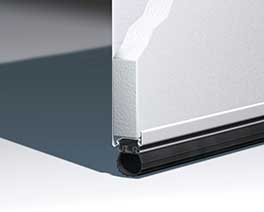Hey guys, welcome to DoorCast.
Hope you guys are doing well. We’re coming up on the holiday season. It’s Thanksgiving week when I’m recording this and the weather is getting chilly here in Atlanta, Georgia. I know across the country, the temperatures are dropping and normally that means for garage door companies, we’re getting a lot of service calls from broken springs. The springs get a little bit more stressed. It’s a metal, so it obviously doesn’t do as well in cold weather. So the springs get more brittle and end up breaking, causing your door not to open. But that’s not what we’re here to talk about today. With the cold weather, we’re going to talk about insulated garage doors.
So if you are in an environment where it’s extremely hot or extremely cold, we’re going to spend a little time today talking about insulation. And what insulated are garage doors, really, and how to measure them, how to measure the insulation, things of that sort. So we’ll jump right in.
So you have a garage and the walls are insulated that join the house. But nine times out of ten, the walls not joined to the house or not connected to the interior or walls of your home are not insulated. So how important is it to have an insulated garage door? That’s the question. And then how much insulation is enough insulation for the garage? I mean, after all, we’re keeping our car there, we may have a fridge, golf clubs. You may have a water heater, and I’ve heard that it’s important to keep water heaters at room temperature or close to it. So we’re going to talk a little bit about the different door options real quick. I’m going to zoom through that and then we’re going to get to some of this other stuff.
Different manufacturers do things differently. So I’m going to talk about the most popular. You have a builder-grade, non-insulated door. That is almost as if you have a hole in your garage. There is no benefit when it comes to insulation value. Also, they’re measured as R-Value or U-Value. Zero. Then you have that same door, it is hollow on the inside and they stuff insulation in it. And that will increase your insulation value from roughly zero to six to nine range, six to eight. We’ll call it six to eight. And that’s if the insulation is as thick as the door and the door is two inches thick. So we’re going to assume all the doors are two inches thick. They have a one in the three-eighths door. And I’ll cover one that we sell pretty often.
So you have a non-insulated zero, you have an insulated builder grade door. That’s going to be what we call a two-layer or a vinyl back. And that’s going to give you around six, seven R-Value. Then you have a three-layer door. It’s essentially the same thing, we just put steel on the back. So we wrap the insulation. So you got steel in the back, insulation in the middle, steel in the front. And it’s polystyrene, just like the two-layer door. So one layer of steel, how much insulation is one layer of like 27 gauge steel going to give you? Not much. It may trap some of the hot or cold weather in the door rather than allowing it to pass through a little bit better. So most of the time you’re going to see that being around eight, nine, and a half percent … or I’m sorry, I keep saying percent. Eight to nine and a half R-Value.
The next step up is a one in three-eighths urethane door. And urethane is where they inject the doors. They build them, construct them typically and then inject them and the urethane expands and hardens up against the walls. And gives you a really good, a little bit more dense insulation. So with that, I know for a fact like Clopay builds a good one in the three-eighths door with the gallery collection or the classic. And those doors will have like 12.9 R-Value.
And what’s great about that is, is that in most homes you’re going to probably have about a 13 R-Value insulation. And it could vary, depending on the states that you live in. States, county, who built your home, all that stuff. But there are like regulations around R-Values. And I think, if I’m not mistaken and I’m not a builder, so don’t hold me to this. The lowest, I think I’ve ever heard is nine that they were allowed to put in the walls, ever in any state. But I could be wrong, so don’t fact-check me and give me a hard time on that. But it’s something to just process, but most homes I think have R 13, especially here in the Atlanta market.
So this door would match up really well with the walls that are insulated. So that’s good. Then we have the R 18, which is going to be … a lot of manufacturers make a two-inch urethane door. It’s a lot denser, much thicker than the last one. And that’s going to give you great insulation. Now, is the 18 overkill? If you’re living up north in the extreme colds, probably not. If you’re living in the Atlanta market where it’s most extreme heat, probably. The price jump from a three-layer polystyrene door to a three-layer urethane door is pretty significant. I don’t need to over-exaggerate. But it’s the biggest jump of all of them. So going from the one-layer or to the two-layer, two-layer to the three-layer and then three-layer to the three-layer urethane, that is your biggest jump by far. Especially if you get windows because a lot of times the windows need to be insulated. So that’ll help the price jump up, too.
Now it could be worth it to you. There have been scenarios in the past where we’ve had customers complain about the urethane doors, probably doing too good of a job. Like I’ll give you an example. I had a customer in Gainesville who had us install a urethane door, and I think an opener. And we came out and we installed the door. And she calls us back and she’s like, “Look, I know this is going to sound crazy. But for one, whatever reason, when I walk out into my garage, it’s really, really hot. And it’s like extremely hot.” So we started investigating, trying to figure out. We went out, we took a look, we just told her, “Hey, we suggest maybe cracking the door for 30 minutes when you come home. Because maybe the heat from the car is getting trapped in instead of trying to keep the heat out.” And that ended up being the case. So that is something to take into consideration when you’re shopping for a super high 18 R-Value urethane injected garage door.
That’s why I think the nine and a half, the three-layer polystyrene, especially for the environments in Georgia are perfect. Or the one in three-eighths urethane door. But some people will say, “Hey, we love the insulation value of the two-inch thick urethane door. And we’ve also been told that it’s dent resistant.” That is untrue. Urethane will not prevent your door from getting dented. What it will do is provide more durability. So it’s not going to be dent resistant. I would say it’s just going to be less likely to be dented on things that are going to hit it that are not as heavy or hit as hard. But you absolutely can dent a urethane injected door.
So in the past, I’ve had samples and allowed people to throw things at them, whether it’s basketballs or baseballs, just kind of give an idea of how much force it takes. And on the three-layer door, it’s quite a bit of force. Those doors are built very well if you get them from the right manufacturer. So all things considered, just to recap, you really have, I think, five options, for the most case. You have the one-layer non-insulated, two-layer insulated, three-layer polystyrene insulated. You have the three-layer, one in three-eighths, urethane injected and the two-inch urethane injected garage door.
And all things to consider when you’re choosing those, is what walls in your garage are insulated? Which walls are not insulated? Is there room above the garage that you are having trouble heating or cooling during extreme heat to cool? And do you mind having car trap heat? Do you have a water heater in the garage? Those are all things that, I think, you should take into consideration when shopping for a garage door and looking for an insulated door. Nonetheless, like all the steel doors in my opinion are pretty affordable and of great value.
Now, I want to talk about some specialty doors real quick before we jump off. I get the question a lot because we do a lot of glass doors, a lot of glass doors. And one of the things that I feel are important is people should understand that, yes, you can get a glass door with insulated glass. You can have gas put in it to help out. You can inject the frame with urethane. There are companies out there that are sliding polystyrene inside these doors, which is ridiculous, in my opinion. I think that is the biggest joke, is sliding polystyrene into a hollow aluminum frame and calling it insulated. But we have urethane injected frames that we can get, we have insulated windows.
The question is, is like, are we really getting the R-Value out of that? Are you really getting the insulation? And it’s really hard to measure, in my opinion. You can get [Lowy 00:11:29] glass, all kinds of things. All good things to consider, but I don’t think you buy glass doors for efficiency. I think you buy them for appearance. They’re absolutely gorgeous. But just keep in mind, like we do a lot of them in like living rooms, basements, countertops, kitchens, bars, restaurants, and they do a pretty good job. Like it’s not bad. And we’re here in Atlanta, so keep that in mind. Probably not as good as say like, Michigan or New York, something like that, South Dakota, North Dakota, all those Northern states that just get it like super cold, probably not a great solution. But down here, glass garage doors are a great solution. And for everyone we’ve installed one in, in the home, we’ve not had one complaint about temperature control.
So then we got wood doors, which believe it or not, they’re actually building wood doors hollow on the inside and insulating them. And that definitely helps. I would say that wood is going to have a lot more pass through just because of the material and some of the gaps in the door. It’s not wood, it’s not perfect. So that too is going to be a little bit different. But I still think you could probably achieve a five or six R-Value out of a wood door if it’s insulated on the interior. So that’s another option. Plus you have the wood on the outside, on both sides, front and back. So keep that in mind.
And I think lastly, the only thing that I want to discuss is the R-Value versus U-Value. I’m no expert, but what I can tell you is this is kind of like the horsepower in the garage door openers, which is a joke. But R-Value, it’s measured by taking one by one, like a one tall, one wide sample of something. And then they have like these little radar guns that they can test to see what the temperature’s going to be, I guess when it comes on the other side. Heat and cold pass through or whatever. And that’s how they get their rating. Ideally, that’s a good idea, but the problem is, is that garage doors are installed with windows, they’re installed with vinyl trim, they’re stacked on top of each other. And there’s like literally grooves where the joints come together.
And so U-Value is supposed to take all those things into consideration, not just the R-Value of what, as a one square inch sample of the door would be. Which makes a lot of sense. Because one square inch of the most insulated part of the door doesn’t mean that there’s no air passing through between the sections. If the … excuse me. If the vinyl trim’s not installed properly, you have all of those things to take into consideration. If the windows aren’t insulated, but the door is, all these things have to be considered when trying to come up with the idea of how insulated it is.
And then also like we talked about earlier, how insulated are the walls in the garage? Are you going to get your desired return on investment by doing this if your walls are not insulated? So all those things have to go into consideration. And the one little bonus I would tell you is like, if it is an insulated garage door, typically they’re going to be a lot quieter than the builder-grade non-insulated. So if the sound is something that’s important to you, you may want to take into consideration purchasing an insulated three-layer door because they are significantly quieter than one layer. Plus you get the added benefit of the cooling and heating factor.
I hope you guys enjoyed this episode, talking about garage door insulation. And if you have any questions, don’t hesitate, reach out to us. This is Ryan with Aaron Overhead Doors here in Atlanta, Georgia. Have a wonderful day.
























